

- Changing ownership of a networkview object how to#
- Changing ownership of a networkview object full#
- Changing ownership of a networkview object windows 8#
This section describes how an attacker might exploit a feature or its configuration, how to implement the countermeasure, and the possible negative consequences of countermeasure implementation. When a local setting is greyed out, it indicates that a GPO currently controls that setting.

Settings are applied in the following order through a Group Policy Object (GPO), which will overwrite settings on the local computer at the next Group Policy update:

The user must take ownership to complete the transfer.Ī user who has the Restore files and directories user right can double-click Other users and groups and choose any user or group to assign ownership to. The current owner can grant the Take ownership user right to another user if that user is a member of a group defined in the current owner's access token. Ownership can be transferred in the following ways: By default, the Administrators group is given the Take ownership of files or other objects user right.Īnyone or any group who has the Take ownership user right on the object.Ī user who has the Restore files and directories user right. This section describes features, tools, and guidance to help you manage this policy.Ī restart of the computer is not required for this policy setting to be effective.Īny change to the user rights assignment for an account becomes effective the next time the owner of the account logs on.Īn administrator. There are no differences in the way this policy setting works between the supported versions of Windows that are designated in the Applies To list at the beginning of this topic. Default values are also listed on the policy’s property page.ĭomain Controller Effective Default SettingsĬlient Computer Effective Default Settings The following table lists the actual and effective default policy values for the most recent supported versions of Windows.

GPO_name\Computer Configuration\Windows Settings\Security Settings\Local Policies\User Rights Assignment Default valuesīy default this setting is Administrators on domain controllers and on stand-alone servers.
Changing ownership of a networkview object full#
Because owners of objects have full control of them, only assign this user right to trusted users. Assigning this user right can be a security risk.This policy setting is supported on versions of Windows that are designated in the Applies To list at the beginning of this topic.Ĭonstant: SeTakeOwnershipPrivilege Possible values Owners can always change permissions to objects, even when they are denied all access to the object. The owner controls how permissions are set on the object and to whom permissions are granted.īy default, the owner is the person who or the process which created the object. This policy setting determines which users can take ownership of any securable object in the computer, including Active Directory objects, NTFS files and folders, printers, registry keys, services, processes, and threads.Įvery object has an owner, whether the object resides in an NTFS volume or Active Directory database. This security policy reference topic for the IT professional describes the best practices, location, values, policy management, and security considerations for this policy setting.
Changing ownership of a networkview object windows 8#
Applies To: Windows Vista, Windows Server 2008, Windows 7, Windows 8.1, Windows Server 2008 R2, Windows Server 2012 R2, Windows Server 2012, Windows 8


 0 kommentar(er)
0 kommentar(er)
